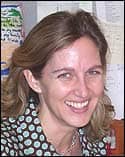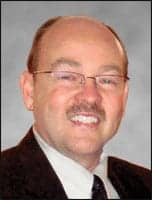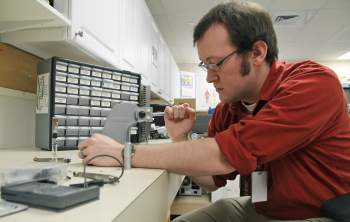
Kyle Fitzgerrel uses a dental bearing press to rebuild a dental handpiece.
Flexibile: adaptable, pliable, bendable. Many clinical engineering teams have discovered that flexibility is key to customer service, quality, and excellence. At Our Lady of Fatima Hospital, North Providence, RI, an affiliate of CharterCARE Health Partners, this attribute is tantamount to survival, as well as success.
With an inventory of 3,850 pieces of equipment, a team of four full-time employees and one per diem, and a tight budget, the facility’s clinical engineering department has used its adaptive skills to maximize equipment life cycles, prioritize work, and expand team member knowledge. Its creativity has helped it to save money and improve service with unique solutions, such as trades and a committed training budget.
In fact, the question of training is the one area where the team may be inflexible. Thomas Citak, AAS, the manager of the clinical engineering department at Our Lady of Fatima Hospital, has secured an annual budget for the team solely for this purpose. “We’ve worked closely with our finance department to set up—for the first time this year—an account with an annual budget for biomed training,” Citak says. The account will have money placed into it every year (the amount will vary), and the department then manages the money, determining how to best spend the dollars.
As with many hospitals, often those dollars are spent on classes that enable the team to bring the service of additional equipment in-house. Citak used this argument to help secure the training budget. “Rather than dump money into contracts, we can use it, year after year, to slowly train the staff,” Citak says.
Each member performs as a specialist as well as handling many different general devices. The techs have areas for which they are the primary cover, but all can respond to general needs. Cross training is used to share knowledge about simpler equipment; items categorized as life support remain under the purview of the technician trained.
Training is particularly helpful for a staff that often finds it must squeeze as much value out of a piece of equipment as possible. How this happens is left up to the individual team member. In general, each is given the flexibility to create a schedule and process to ensure equipment is properly maintained, which has had great success. “I like the flexibility. It’s good for the hospital, and it’s good for us,” says Mark Trimmer, AAS, biomedical equipment engineer, radiology specialist.
Flextime
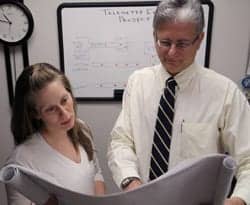
Kim Bogan, a BMET III, and Tom Citak, manager of the clinical engineering department, review floor plans for a telemetry installation project.
The team itself has flexibility. Citak manages the department. The three full-time technicians include Trimmer, the biomedical equipment engineer, radiology specialist; Kyle Fitzgerrel, AAS, a BMET II; and Kimberly Bogan, BS, a BMET III; as well as one per diem staff member, John Clancy, AAS, a former employee who works on radiological equipment.
Citak has found it difficult to find experienced personnel in the area, but when hiring he has focused on finding the right skill sets to meet the hospital’s needs. The decision to bring on Trimmer was tied to significant cost savings. Trimmer had previously worked for a manufacturer. With his skills, the facility could eliminate a contract worth roughly $75,000.
Each team member has unique areas of expertise but may be called upon to step outside of those areas. “Being a smaller shop, we get our hands on everything, and we’re all very well versed on a variety of equipment,” Bogan says. “So if someone calls in sick or is on vacation, we can easily slide in and keep things running.”
Last-minute repair calls are prioritized according to need. Obviously, emergent maintenance of life support equipment requires more urgent attention than routine preventive maintenance (PM). “We are permitted a 30-day grace period,” Bogan says. “We’ll do our best to get our PMs done in the month assigned, but it can be pushed back a week or two to allow us to get the important stuff done first.”
The team does hold regular meetings to review status, but Citak prefers to let them operate independently. “I view the PM schedule monthly. As long as they are getting done within The Joint Commission requirements and there are no complaints from the hospital staff, there’s no need for me to look over their shoulders,” Citak says.
The clinical staff has options for contacting the clinical engineering team, including through an electronic work order system. “The majority of the time, though, they call. And if it’s not urgent, they will wait until they see us,” Bogan says.
Calls are fielded in the shop. If it falls within someone’s specific expertise, it is referred to that tech. Otherwise, whoever is in the shop will handle the request. Documentation is therefore key. “If an instrument breaks down again in a similar fashion [to another incident], you don’t have to reinvent the wheel, and it helps to save time,” Bogan says.
As team members prioritize their work, they have the additional flexibility to move their schedules around. The two radiology techs often schedule work after hours, which maximizes clinical uptime. To facilitate this flexibility without increasing cost to the hospital, Our Lady of Fatima modified its pay structure. Overtime is not paid out for more than 8 hours a day but for more than 40 hours a week. And holidays worked can be exchanged for compensatory time off elsewhere. “The change has really helped us to do our jobs. We can load the week accordingly and not penalize the hospital for doing it,” Trimmer says.
Stretching the Limits
The freedom to do what it takes to get a job done extends to the job itself. With budgets extremely tight, it’s imperative to extend the life of equipment as much as possible. Each team member is responsible for ensuring its safe and proper performance, no matter its age.
This means all manufacturer-recommended procedures for service and maintenance are followed, and users are educated on proper use. “Getting the staff involved can help to extend equipment life,” Bogan says. As easy but efficient examples, she specifically cites proper handling—to ensure equipment is not being abused—and immediate communication, “rather than working around it for months and possibly causing more damage,” Bogan says.
As equipment ages, the biggest challenge to maintenance is locating appropriate parts. “It becomes very hard to find parts on equipment that is obsolete or end-of-life,” Fitzgerrel says. He recommends third-party vendors who may be able to continue to supply parts moving forward—but he also advises shopping around.
“I always get multiple quotes on any type of part we need,” Fitzgerrel says. He starts with the manufacturer (obtaining the number and price), then checks with a sales rep, then calls third-party sources. eBay is always an option, but not necessarily one he suggests, noting reliability may be questionable.
Once a discussion has begun, biomeds should not discount the value of negotiating. “It sounds cliché, but don’t take the first price,” Trimmer says. “There are third parties out there that provide similar services. And everybody needs to make money, but the question is, how much?”
If stuck, the team members will turn to one another. “I’ve got a bulletin board full of remarketers, vendors, and other second-source parts vendors, and my staff is the same way. But we work together and share information,” Citak says.
If they still find themselves stuck, the biomed community can be another useful resource. Citak values online resources, such as listservs and message boards. “People share information on parts or service manuals,” Citak says.
Creative Solutions
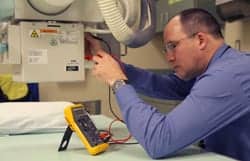
Mark Trimmer, the radiology specialist, troubleshoots a digital radiographic system.
If the team is still stuck, it may be time to retire a piece of equipment. Just recently, it was decided that a patient warming blanket unit could no longer be maintained. “All of the parts were obsolete, and the quote to repair the board (from a general electronics board repair shop) was no longer cost-effective,” Fitzgerrel says.
Once it has been decided to retire a unit, the biomed department will work with environmental services to remove the device, although sometimes it may be useful in other ways. When Our Lady of Fatima bought a new MR machine, the vendor offered $30,000 for the old MR trailer. Trimmer was able to sell it through a remarketer for $145,000. (The money went into the hospital’s general budget.)
In another instance, Citak was able to negotiate a trade using an older sterilizer that had been retired. A medical equipment liquidator was seeking just such an instrument, while Citak was looking for new warming cabinets. Rather than sell the sterilizer to the liquidator, give the money to the hospital, justify the budget for a new expenditure, and negotiate a sale, he worked the barter system: one sterilizer for two warmers, plus the vendor deinstalled the sterilizer and delivered the warmers at no charge. The process was so smooth that Citak has continued to work with the vendor, most recently saving $2,500 to $3,000 in transport costs as a result.
Deals like this, however, are reserved for equipment that is not life support. “We usually try to buy new for life support systems and would usually go with the refurbished for second-tier systems,” Trimmer says.
Expanding the Mind
Training and certification help to ensure that the team has the knowledge and expertise to maximize the life of its equipment while ensuring quality and patient safety. “Whenever management sees an opportunity to move something in-house rather than getting it taken care of through a third party or vendors, they definitely take that opportunity to get one of us trained,” Bogan says.
“We do try to drop as many contracts as possible, and this is where service training comes in,” Citak says. But the benefit is not solely for the hospital. “I’ve never had anybody refuse to go to school. It provides an advancement opportunity for the technician,” he says.
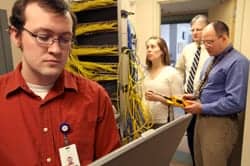
At the telemetry servers and substations in an IT closet, the team loads software revisions.
Technicians are matched to classes based on the hospital’s need and the individual’s expertise and workload. “Every training class is targeted to save money. We target a particular contract or a particular excessive cost, and we aim a training class at that,” Trimmer says.
If something is new, it goes to whoever has “room on their plate.” Team members can also suggest new areas for development.
Since starting in August of 2011, Trimmer has already completed an extensive training class with a focus on x-ray. Bogan handles ultrasound equipment as well as anesthesia instrumentation. Fitzgerrel covers dialysis, select ventilation lines, and smaller items, such as dental handpieces.
Where possible or necessary, the team uses cross training. “Dialysis and ventilators are considered life support, and usually, the manufacturer only wants the person who has been trained on the equipment to actually touch it,” Fitzgerrel says. “But, if there is a common problem that we see, we’ll go ahead and cross train on that specific problem. Smaller devices, like dental handpieces, I can certainly cross train on because their use is not life-threatening.”
When possible, the department will negotiate training into the written contract, but Citak notes this is becoming increasing difficult. “Vendors used to throw training in for free, but now, they are reluctant to do so, and sometimes charge an exorbitant amount for school,” Citak says.
With the threat of turnover, hospitals have to carefully evaluate training expenses, weighing benefits against potential risk. “The hospital typically looks for a [return on its investment] within a year,” Fitzgerrel says.
With the new accounting arrangement, administrative approvals for training are no longer required, and growth can occur more organically. The value has already been justified. “Once they saw the contracts dropping and where we are saving dollars, they recognized the savings and approved the budget,” Citak says.
The flexibility on the part of clinical engineering and upper management reflects a teamwork that recognizes adaptability is the best way to deal with limited resources. “Our manager allows a great deal more flexibility than most managers allow, and I think that’s the key to our success,” Trimmer says. Flexibility at Our Lady of Fatima means: accessible, capable, possible.
Renee Diiulio is a contributing writer for 24×7. For more information, contact .


